Space as a tool to address climate challenges: Need for ‘Indigenuity'[1]
by Anmol Dhawan, National Law University, Delhi., Space Generation Advisory Council – Sustainability Project Group
Globally, patterns of sea-level rise, forest fires, natural disasters, and climate hazards threaten ecosystems and humankind. The adverse consequences of climate change impact food, health, security, livelihood, as well as economic and political stability[2] and affect fragile countries in the global south and vulnerable communities disproportionately.[3] The climate crisis creates millions of ‘climate refugees’.[4] Relocation support for vulnerable communities could immensely benefit from integrated space technology applications for monitoring the impact of climate change.[5]
The effects are global. Nyngatom, a pastoral community in south-west Ethiopia facing adverse effects of climate change, is modifying its seasonal calendar as a coping mechanism.[6] In Alaska, lowered whale populations have profoundly impacted the Iñupiat society, who are forced to rely on technology.[7] Rising sea-level and natural disasters have led to forced displacement in the Asia-Pacific.[8]
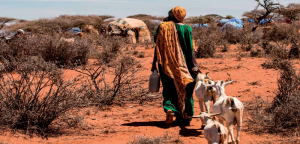 Africa [©UNICEF 2017, Nahom Tesfaye] [9]
Africa [©UNICEF 2017, Nahom Tesfaye] [9]
Communities are already trying to incorporate technological innovations and information to their indigenous knowledge to predict patterns of climate change and plan towards other pastures. In the Arctic, Sami and Nenets reindeer herders are combining their traditional knowledge with remote sensing using Landsat and AMSR-E satellite systems[10] to improve decision-making for reindeer herding and adaptation.[11] In Africa, meteorological scientists have partnered with the Kenyan Nganyi community and Nessa farmers from Malawi for integrated weather forecasts using indigenous and conventional methods.[12] Two-way synergies with indigenous groups, which have systematic experience of climate observations and traditional knowledge, are thus crucial to climate action.
Space technology and international co-operation could help these vulnerable communities adapt to changing native lands and the environment. Sea-level rise, changes in the marine environment, and water quality can be mapped through earth observation [Landsat 8:Dead Sea].[13] Observation assessment and data sharing related to fisheries management and freshwater management could further enhance the community transition to technology, which has been initiated in groups like the Iñupiat. Land-fertility, agricultural suitability, and greener pastures could be assessed through earth resources observation as well [MERIS: The Nile Delta].[14]
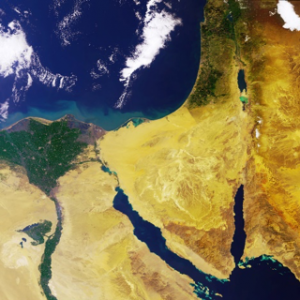 The Nile Delta and the Sinai Peninsula shot by Landsat 8’s image of Dead Sea (MERIS) [© ESA]
The Nile Delta and the Sinai Peninsula shot by Landsat 8’s image of Dead Sea (MERIS) [© ESA]
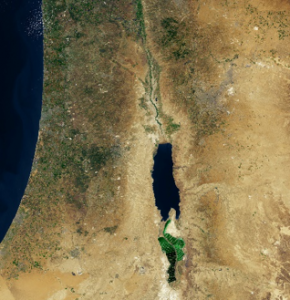
International co-operation between space agencies and states could enhance effective solutions for climate action. Remote sensing can assist in sharing valuable data and information to monitor outbreaks and for institutional assessment of the impact of climate changes and weather events, water management, natural and artificial phenomenon, and the like. Geospatial information services like EO4Hum, which uses imagery from various satellites, such as Copernicus Sentinel-1 and Sentinel-2, monitor refugee camps, which helps NGOs to estimate the number and location of people who require vaccinations, food, water, and shelter.[15] Based on available earth observation data, Médecins Sans Frontières provided extensive healthcare and nutritional support in refugee camps in Cameroon.
Similarly, conditions for migrant camps and climate refugees around the world can be ameliorated through adaptive planning for emergencies, based on data collected from the safety of space.
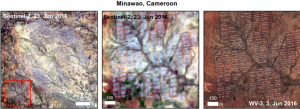 Refugee camps in Minawao, Cameroon, imaged by the Copernicus Sentinel-2 and WorldView-3 satellites [© ESA]
Refugee camps in Minawao, Cameroon, imaged by the Copernicus Sentinel-2 and WorldView-3 satellites [© ESA]
Satellites can assess vulnerability and support adaptive action. For example, satellite imaging of the Australian bushfires helped mitigation efforts pre-emptively and even helped both during and after the disaster. In light of the “benefit of mankind” objective of space exploration, countries must be encouraged to share climate data gathered by satellites, and free and open data policies through implementation of the COP 21 agreement.[16] Cooperative monitoring and data sharing could aid disaster management and displacement planning by gauging the extent of changes to ecosystems. [17]
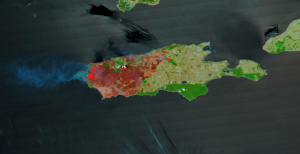 NASA’s Terra satellite’s image of Kangaroo Island [©Nasa Worldview]
NASA’s Terra satellite’s image of Kangaroo Island [©Nasa Worldview]
Space sector co-operation with developmental agencies could aid communities to the extent of information sharing and development to reduce vulnerability to rapid climate change or natural disasters.[18] Space agencies and satellite research systems complementing indigenous knowledge mitigates risk for vulnerable groups and can pave the way for a unified response to climate change, as aimed at through Sustainable Development Goal 13.
References
[1] Boesen, L.H., Hinton, S. and Freeman, S., 2016. Indigenuity: Reclaiming our Relationship with the Land. In Land Restoration (pp. 497-506). Academic Press.
[2] Sustainabledevelopment.un.org. 2020. Space And Climate Change: Use Of Space-Based Technologies In The United Nations System. [online] Available at: https://sustainabledevelopment.un.org/index.php?page=view&type=400&nr=361&menu=1515 [Accessed 22 June 2020].
[3] https://www.worldbank.org/en/topic/climatechange/overview
[4] Siyech, M., Mehra, J., Gambhir, M., and Notezai, M., 2020. Climate Change In India And South Asia: Intensifying Local Grievances. [online] South Asian Voices. Available at: https://southasianvoices.org/climate-change-in-india-and-south-asia-intensifying-local-grievances/ [Accessed 22 July 2020].
[5] UNOOSA.org. 2020. Sustainable Development Goal 13: Climate Action [online] Available at: https://www.unoosa.org/oosa/en/ourwork/space4sdgs/sdg13.html [Accessed 19 July 2020].
[6] McLean, K.G., 2012. Land use, climate change adaptation and indigenous peoples. United Nations University, 30.
[7] Sakakibara, C., 2011. Climate change and cultural survival in the Arctic: People of the whales and muktuk politics. Weather, Climate, and Society, 3(2), pp.76-89.
[8] Siyech, M., Mehra, J., Gambhir, M., and Notezai, M., 2020. Climate Change In India And South Asia: Intensifying Local Grievances. [online] South Asian Voices. Available at: https://southasianvoices.org/climate-change-in-india-and-south-asia-intensifying-local-grievances/ [Accessed 22 July 2020].
[9] Thales Alenia Space, 2020. Climate Change & Satellites | Thales Group. Available at:
https://www.thalesgroup.com/en/worldwide/space/news/climate-change-satellites [Accessed 13 July 2020].
[10] Maynard, N.G., Yurchak, B., Etylin, V, et. al., 2008. Eurasian Reindeer Pastoralism in a Changing Climate: Indigenous Knowledge and NASA Remote Sensing.
[11] Maynard, N.G. et. al, 2005, Space technologies for enhancing the resilience and sustainability of Indigenous Reindeer Husbandry in the Russian Arctic. In Proceeding of the 32nd International Symposium on Remote Sensing of Environment, Global Monitoring for sustainability and security. St. Petersburg, Russia.
[12] https://unesdoc.unesco.org/ark:/48223/pf0000216613
[13]ESA.int. 2020. Dead Sea, Middle East. Available at: <https://www.esa.int/ESA_Multimedia/Images/2014/11/Dead_Sea_Middle_East [Accessed 15 July 2020].
[14] ESA.int. 2020. The Nile Delta and The Sinai Peninsula. Available at: https://www.esa.int/ESA_Multimedia/Images/2005/04/The_Nile_Delta_and_the_Sinai_Peninsula [Accessed 22 July 2020].
[15] ESA.int. 2020. Space Technology Improves Conditions For Refugees. [online] Available at: https://www.esa.int/Enabling_Support/Preparing_for_the_Future/Space_for_Earth/Space_technology_improves_conditions_for_refugees [Accessed 17 July 2020].
[16] Sustainabledevelopment.un.org. 2020. Space And Climate Change: Use Of Space-Based Technologies In The United Nations System. [online] Available at: https://sustainabledevelopment.un.org/index.php?page=view&type=400&nr=361&menu=1515 [Accessed 22 June 2020].
[17] Bean, H., 2020. A Bridge Between Indigenous Knowledge And NASA | Waterloo Stories. Waterloo Stories. Available at: https://uwaterloo.ca/stories/global-impact/bridge-between-indigenous-knowledge-nasa [Accessed 26 June 2020].
[18] Bean, H., 2020. A Bridge Between Indigenous Knowledge And NASA | Waterloo Stories. Waterloo Stories. Available at: https://uwaterloo.ca/stories/global-impact/bridge-between-indigenous-knowledge-nasa [Accessed 26 June 2020].

